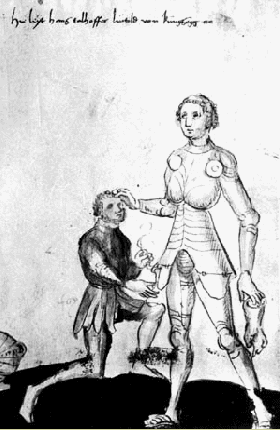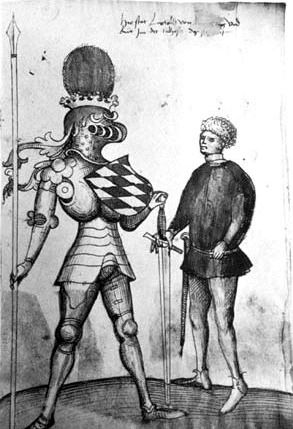

It is a common misconception that the combat in the medieval period was crude and haphazard, relying on brute strength over skill. Victorian authors such as Egerton Castle, one of the premier historians of swordplay of his time, derided the "rough untutored fighting of the Middle Ages" and compared in unfavourably with the elegance and grace of later period rapier play. Modern scholars, however, take a different much different view of the martial skills of medieval warriors. A careful study of surviving combat manuals (fechtbuchs, in German) gives every indication that Western martial arts were every bit as sophisticated as those of the East. Three surviving treatises on late medieval combat written by Hans Talhoffer are perhaps the best known of these rare documents as they were reprinted at the beginning of this century by an officer in the Austria-Hungarian Empire by the name of Gustave Hergsell.
Hans Talhoffer was from Swabia, a region of Southern Germany which now lies chiefly within the present states of Baden-Wurttemberg and Bavaria. This region derived its name from the Suevi, a Germanic tribe which settled in the area during the great migrations of the fifth century. Swabia was long famed for its martial traditions, and by the fifteenth century the techniques its master swordsmen, such as Johannes Liechtenauer, had influenced fight manuals both in Germany and Italy. An unfinished fechtbuch of 1389 written by Hanko Doebringer, possibly a pupil of Liechtenaur, sets out much of his masters' theory. Matthew Galas, an independent scholar who is preparing a book on early German swordsmanship, writes of this fechtbuch;
"Despite his failure to complete his work, Doebringer manages to convey the theoretical basis for the German art, which is surprisingly modern in tone. Concentrating on the importance of seizing the initiative, on maintaining the offensive, and evading the opponent's attempts to find the blade, Doebringer at times sounds like a modern epee coach. In another section, Doebringer discusses the time advantage of the thrust over the cut &endash; a theoretical concept usually ascribed to the Italian rapier masters. In addition, Doebringer describes how Liechtenauer divided the opponent's body into four target areas - a division still used in modern fencing. Finally, dispelling the misconception that medieval swordsmen relied on strength alone, Doebringer states that a weakling using Liechtenauer's art would be as likely to win as a strong man. In sum, Hanko Doebringer's observations make clear that medieval fencing masters - at least in Germany &endash; had developed their art to a much higher degree of sophistication than they have previously been given credit for." (Galas, M., "Setting The Record Straight: The Art of the Sword in Medieval Europe")
The fame of the Swabian fighting arts was not confined to Germany, as the author of a early Italian fight manual, the Flos Duellatorum (Flower of Battle, 1410) claims to have studied under a "Master Johannes, called the Swabian." Talhoffer's fechtbuchs are thus part of a long tradition of combat manuals deriving, to a great extent from the teachings of the legendary Johannes Liechtenaur. Mr. Galas' book should be released soon, and should shed more light on this swordfighting tradition.
Little is actually known about Hans Talhoffer, other than that what can be gleaned from his manuscripts. At some point, he seems to have been a servant to a Swabian squire (Hergsell uses the french word damoiseau) by the name of Leutold Königsegg.* There are several illustrations in the 1459 edition of his fechtbuch which show the author attending Königsegg in duties we would most associate with a squire. In plates 13 to 42, Talhoffer is assisting him in preparation for what appears to be a judicial duel, and is shown helping him into his armour, carrying his weapons into the list field and attending him in different types of tournament armour (below).
Talhoffer's fechtbuchs survive in at least 3 editions; 1443, 1459 and 1467.** Two are preserved at Gotha (1443 and 1467) and the third, formerly at Schloss Ambras, is now in Vienna. Although there is not sufficient space in this article to examine these works in depth, I have made the following outline of the salient points, along with a few observations on some of the more remarkable aspects of these fascinating documents.
*A town and a castle, both named Königseggwald, can be found north of Friedrichshafen in present day Baden-Wurttemberg. This may well be connected with Leutold's family.
**There would appear to be yet another edition at Copenhagen, mentioned in a 1987 article in Waffen und Kostümkunde, vol. 29, by Hans-Peter Hils, but I have yet to track down more information. The illustrations from it which were in the article were of plates that do not appear to be in any of the editions printed by Hergsell, and they are of a quality to suggest that they akin to the 1467 edition, so it may well be another edition dating from around that time.

